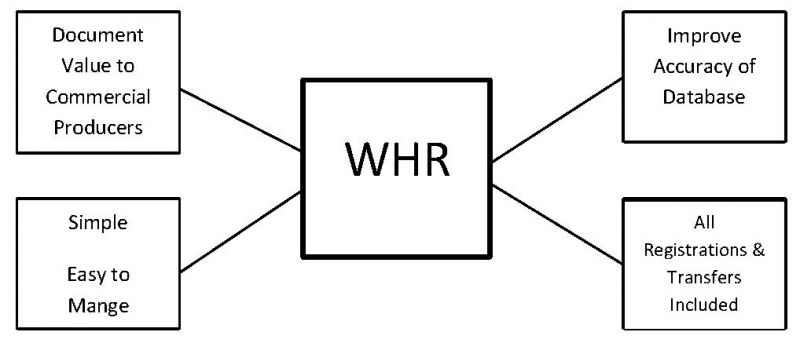The Whole Herd Reporting approach offers many benefits to both seedstock and commercial producers. Building and documenting value are key in nearly every segment of our industry. To reap the benefits and generate profit it is the primary responsibility of seedstock producers to provide predicable, reliable genetics for our customers. Providing them with as much knowledge about our product as possible will help them remain a profitable entity and continue to be a solid, supportive client and customer. At the breed association level that means, and is a big benefit of WHR, a more accurate database.
The ability to predict genetic performance is dependent upon the accuracy of the breed association’s database.
Whole Herd Reporting is a simple and straightforward system. For one the annual assessment fee on each cow, a producer receives a progeny input allowing all performance measurements, weight adjustments, ratios and EPDS to be input and reported for the progeny and the cow. The progeny can then be registered and transferred at no additional cost. There are no separate registration or transfer fees.
The billing system is simple and easy to manage for both the producer and the Association. Assessment fees for active Salers breeding-age females are $20.00 per year. The non-Salers (Appendix) females are $12.00 per year.
The Association uses one schedule for WHR, which includes both spring and fall-calving herds. Breeder inventory sheets are sent out the first part of January with a request to send in disposal information for those females no longer in the herd. The active inventory list is due back to the Association by March 31. Only breeding-age females born previous to May 31 will be on the list. If an animal is born after the date but does calve in the current year, a breeder can still submit her progeny information. Her WHR fee will be billed at the time of progeny information submission. The fees are split in two installments-the first half, due with the updated inventory listing, must be returned to the Association by March 31. On July 1, the second billing installment is sent out from the Association. This installment is based on the females submitted as active from the breeder by the initial March 31 deadline. The second installment is not adjustable by the breeder and is due by September 30.
Common Questions
What is the fee for transfers of inventory age females or bulls?
If the animal has never been transferred, the transfer for any age of female or bull is free. If an animal has already been transferred once, the transfer fee will be $7.00 per owner.
On jointly owned females, who pays the Whole Herd Reporting fee?
The Whole Herd Reporting fee should be paid by the membership submitting the progeny information. The Association will not know which owner plans to submit the progeny performance therefor all owners will be billed. The owner not submitting the progeny information can adjust the amount off the invoice and note the animal is multiple owned. Do not dispose the animal off the inventory listing.
How are embryo transplant calves handled?
An assessment fee must be paid on each embryo calf unless the recipient dam is on the active female list. If the annual assessment on the donor dam has been paid, the owner of the donor dam is allowed one calf registration, whether natural or embryo transplant progeny.
How are multiple birth calves handled?
In the case of multiple natural birth calves; twins or triplets, no additional assessments beyond the initial WHR assessments will be incurred.
How are leased females managed?
Leased females will show-up on the lessees’ inventory and the lessee will be reporting the progeny information.
How are foundation females added to the inventory listing?
Foundation females or non-Salers females, now called appendix females, can be added to the inventory listing sent out in January. If a breeder wishes to enter and possibly register progeny sired by a Salers bull, the nonSalers female must be put on the inventory.
Will Whole Herd Registry change how progeny information is reported?
Breeders will still report birth information, then weaning information, then yearling information or birth and weaning information at the same time and yearling information later.
What is the fee to re-activate a cow if she is listed as inactive?
If a cow on inventory is inactivated, a reactivation fee of $40.00 will be required to reinstate the cow. Only one reinstatement will be allowed per cow during her lifetime.

